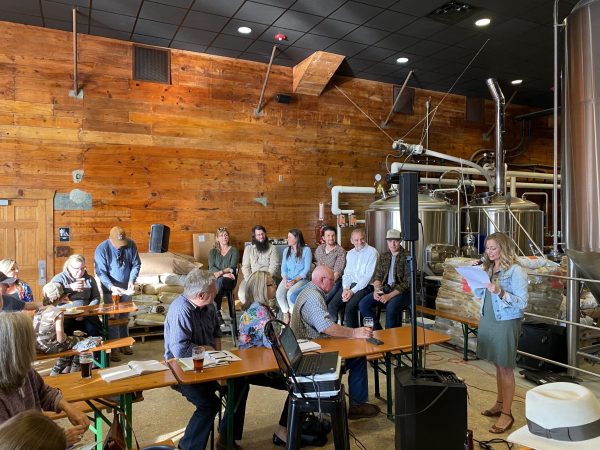Great Plains Regeneration to focus on helping region’s farmers build soil health, develop markets for regenerative agriculture products, revive rural communities
A new organization has emerged to encourage adoption of regenerative agriculture practices across the U.S. Great Plains. Great Plains Regeneration (GPR) was founded by a team of farmers and regenerative agriculture leaders to provide farmer-to-farmer education and market opportunities for farmers in states such as Kansas, Nebraska, North and South Dakota, and Montana.
Executive director Jessica Gnad previously worked as a soil health content consultant and helped manage a crop consulting company with her husband, Shannon. She became passionate about soil health based on her experience working with conventional farmers and advocating for local food production in Kansas.
“I really came to learn about soil health through personal health issues and having a family member diagnosed with organophosphate toxicity*,”* she says. “It really made us question, ‘why are we doing what we’re doing and can we find a better way?’ ”
Gnad credits John Roulac, founder of organic food company Nutiva and executive producer of Kiss the Ground, a documentary film about regenerative agriculture, for spearheading the founding of Great Plains Regenerative.
“John has been a real force in getting Great Plains Regeneration organized and ready to go,” she says. “He’s really lent a lot of his executive leadership in helping us form this.”
After Kiss the Ground was released, Roulac saw that the film would boost interest in regenerative agriculture. He connected with Gnad and Gail Fuller, a regenerative farmer in Kansas, and they decided to form Great Plains Regeneration, which launched this past March.
Why an organization focused on the Great Plains? “If there is one place to make a stand and make regenerative agriculture mainstream it’s that region,” Roulac says. “There’s a groundswell of interest in regenerative agriculture in the Great Plains and other Midwest states that you don’t see in California or on the East Coast.”
Besides Roulac, GPR’s other board members include Fuller; Graham Christensen, a 5th generation Nebraska farmer; Steve DeWitt, a regenerative farmer in Oklahoma; and soil health consultant Liz Haney, who along with her husband Rick developed the Haney Test as a more holistic way of measuring the soil ecosystem. Leading soil scientist Ray Archuleta is on GPR’s board of advisors along with Robyn O’Brien, co-founder of rePlant Capital, and several other farmers.
Farmer-led education in soil health
Soil health is the foundation of GPR’s mission, which is to “collaborate with farmers and ranchers to increase adoption of sustainable practices to regenerate natural resources, enhance biodiversity, and support human and socio-economic resiliency.”
GPR is focusing on three areas: farmer-led education in regenerative agriculture practices, watershed restoration in partnership with Kansas Alliance for Wetlands & Streams, and building markets for regeneratively produced crops and processed products.
A key venue for GPR’s farmer-led education is Fuller Field School, which has been operated by Gail Fuller and his partner Lynette for the past 10 years. The school, which is located on Fuller’s Circle 7 by Fuller Farms, “explores in-depth ecosystem regeneration, both above and below ground, aiming to create a positive impact on restoring soil health.”
“Gail has been introducing farmers, ranchers, civic leaders, and consumers into a deep dive of regenerative agriculture, really before anybody else was calling this regenerative agriculture,” Gnad says.
She emphasizes that GPR is a farmer-led organization. “We have about 25 farmer advisors that we rely on heavily to help us make decisions,” she says. “And I think that what Great Plains Regeneration can do is provide integrity and clarity on the agronomic advice to help people make changes on the farm that are for the better and long-lasting.”
Another key focus of GPR is watershed restoration working in partnership with Kansas Alliance for Wetlands & Streams (KAWS), a nonprofit organization working to connect the waters, lands, and people of Kansas.
“They have a 25-year history doing water restoration work,” Gnad says. “The way that we complement them is we’re going to bring the soil farmers and ranchers into some of the projects that they’re working on to enhance biodiversity.”
Regenerative market development
The third major focus of GPR’s work is developing markets for regenerative agriculture products, which Gnad says is especially important to scaling regenerative agriculture. “A lack of regional markets is definitely a barrier,” she says.
“The idea is how do we reward farmers for building soil health and incorporating regenerative practices?” Roulac says. “Until we do that, farmers don’t have incentives (to adopt regenerative practices). Why not reward farmers in the marketplace for doing the right thing?”
Roulac has been focusing on developing regional markets. Last spring, he visited farmers and processors in Idaho, Kansas, and Nebraska to gain a greater understanding of market possibilities. He sees opportunities with crops such as milo/sorghum and milling of heirloom wheat varieties.
“Just as small craft breweries have shaken up the brewing industry, we see the same potential for flour,” Roulac says.
In fact, there is a nationwide revival of local and regional grain production and flour milling with more than 100 local milling organizations coast to coast.
GPR has developed its own brand, Farmer Eve, which will produce flours made from heirloom wheat varieties such as Turkey Red and grown by the region’s regenerative farmers.
There are existing projects to source regeneratively grown crops directly from farmers in the Great Plains region. Colorado-based Quinn Snacks is working with regenerative farmers such as David Vetter and Steve Tucker in Nebraska to source popcorn, milo, and other crops directly from them.
Gnad sees GPR as a link to develop more of those farmer-brand relationships.
“I would like Great Plains Regeneration to be that connector piece that can determine what the food companies need and then access our network of farmers and tell the brands ‘Here are some farmers that can handle your project.’ ”

Board member Graham Christensen, who also leads Regenerate Nebraska, also sees GPR as a connector to help scale regenerative agriculture production nationwide.
“Great Plains Regeneration speaks to that connective tissue to pull these brilliant farmers and minds that are stakeholders in this conversation together,” he says. “It means enhancing education and doing what’s needed to stimulate a new marketplace that supports larger scale regeneration, which is what we really need right now.”
“Facilitate civic engagement”
Building new markets for regenerative crops and value-added products can also help revive rural communities in the region, many of which have been hollowed out by industrial agriculture with its monocultures of genetically engineered corn and soybeans and livestock factory farms. Gnad is optimistic about that possibility.
“We feel strongly that there’s amazing work being done right now across many states of the Great Plains,” she says. “And if Great Plains Regeneration can help facilitate that civic engagement back to the community, we want to be a part of that.”
Gnad says the response to GPR has been positive. “The response to us launching Great Plains Regenerative has really exceeded what I thought. From the farming community, it’s been very positive because of our focus on farmer-led education and farmer-led projects, and also because the organization is led by producers.”
What is the vision for Great Plains Regenerative? Gnad says: “Kansas Alliance for Wetlands & Streams puts it very simply: it’s about people that are connected to sustaining our natural resources, lands that are prosperous for wildlife and people and





